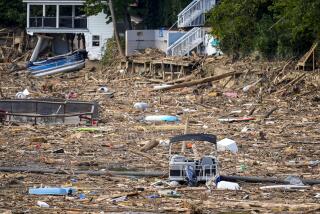Soggy Northeast Assesses the Damage
- Share via
LAWRENCE, Mass. — The long metal drain spout made an excellent javelin, Christian Cruz decided as he sifted through the mountain of ruined household objects outside his house. And the soggy broom served as a fine baton as the 14-year-old led two of his siblings on a parade down Holly Street.
“That’s our refrigerator,” said Jonathan Cruz, 12, gesturing toward the curbside heap of appliances, mattresses, furniture and other family possessions wrecked in the worst flooding to hit this region since 1936.
The Cruz boys and their mother, Lisette Hammonds, were among at least 14,000 Massachusetts residents whose homes were damaged in a four-day weather rampage that started the Friday before Mother’s Day.
The storm claimed at least two lives and dumped up to 17 inches of rain on communities north of Boston as well as parts of southern Maine and New Hampshire. Areas such as this hardscrabble city near the New Hampshire border were especially hard hit when rivers surged over their banks, sending torrents of water into houses and businesses.
The deluge startled a region that is accustomed to extreme weather, but normally expects to savor at least a brief spring. The wet, cold interval persisted, and it was days before brief bursts of sun dried out the waterlogged area long enough to assess the destruction.
Federal and state emergency teams scoured the three states last weekend to “get a flavor of the scope of the event,” said Peter Judge, spokesman for the Massachusetts Emergency Management Agency.
On Monday and Tuesday, additional teams from FEMA and an assortment of Massachusetts agencies inspected dams, bridges and roads around the region. He said federal aid was likely if the area had hit a threshold of $7 million in damage. But it was “way too early” to put a dollar figure on the damage, Judge said Wednesday.
Governors of the three affected states have issued disaster declarations for their storm-damaged regions.
As to whether Massachusetts will receive federal disaster relief, “basically, it’s sit-and-wait right now,” Judge said. “Hopefully it’s not if, but when. The feeling is, we will.”
Government assistance, he said, could come in the form of grants, temporary housing, small-business loans and help with emergency repairs. “We’ll see that laundry list if and when they do make the [disaster] announcement.”
The five most populous counties in New Hampshire also were awaiting word from Washington, said Jim Van Dongen, spokesman for the state’s Bureau of Emergency Management. Van Dongen said Wednesday that about 5,200 households had sustained flood damage and that some people were still pumping out their basements.
Immediately after the storm, about 700 New Hampshire roads and bridges were closed, Van Dongen said, but most are open now.
The 70 or more roads in and around York County, Maine, that were closed soon after the storm have also reopened, said Charlie Jacobs, acting director of Maine’s Emergency Management Agency. Jacobs said Wednesday that the businesses in that southern, coastal part of the state also were largely back in operation. Maine too was hoping for federal assistance, Jacobs said.
In Lawrence, a densely populated neighborhood along the banks of the Spicket River sustained extensive damage. Many basements that were occupied as dwellings were completely flooded.
First-floor watermarks topped 3 feet in some houses. Small businesses, including a record store, lost much of their inventories.
Red Cross workers made the rounds this week, passing out the vitally needed commodities of water and information. Volunteer Mary Leighton said two shelters that had been open in Lawrence since the peak of the storm were due to close soon.
“That’s a good sign,” she said. “It means people are finding places to stay or are able to move back home.”
Gregory Arvanitis, a Lawrence building inspector, shook his head as he emerged from a three-family residence on Exchange Street. Arvanitis declared the property uninhabitable, a total loss.
“I have never seen storm damage like this,” he said. “FEMA should just take this house -- which is what I am hoping.”
Owner Cesar Bernabel pointed to a watermark at 30 inches. Black mold was growing on the walls. Floors had buckled, rugs were destroyed, and wiring lay in hallways with other detritus. “It is so bad,” he said.
Outside her parents’ 13-room home on Daisy Street, Kathy DeDeus recalled what a showpiece the place was when she was growing up 40 years ago. Now, she said, she was not sure about letting her 80-year-old mother and 87-year-old father move back in.
“Look at these floors,” she said, indicating how the hardwood planks were buckling. “I’m just not sure how habitable it is right now.”
Seven months pregnant with her fifth child, Lisette Hammonds threw back her head and laughed when a Red Cross volunteer came by and said this would be a good time to get some rest. Hammonds said she moved her family to Lawrence from Connecticut just last September. She lost clothing, bicycles, her entertainment center and a recently purchased bedroom set when the flood coursed through her first floor. She also lost her refrigerator and freezer.
Hammonds, who relies on disability payments, said it never occurred to her to take out flood or renters’ insurance. “I never heard of that until now,” she said.
She said the storm was “extremely scary,” especially when firefighters ordered the family to leave the house in the middle of the night. “Well,” she said, “at least we got our lives.”
More to Read
Sign up for Essential California
The most important California stories and recommendations in your inbox every morning.
You may occasionally receive promotional content from the Los Angeles Times.













